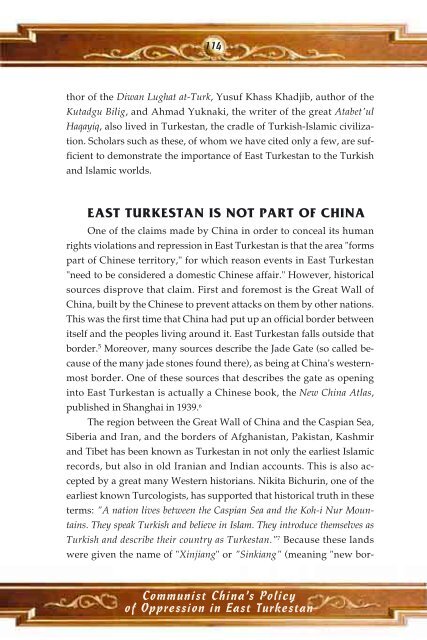Communist China's Policy of Oppression in East Turkestan
Communist China's Policy of Oppression in East Turkestan
Communist China's Policy of Oppression in East Turkestan
Create successful ePaper yourself
Turn your PDF publications into a flip-book with our unique Google optimized e-Paper software.
114<br />
thor <strong>of</strong> the Diwan Lughat at-Turk, Yusuf Khass Khadjib, author <strong>of</strong> the<br />
Kutadgu Bilig, and Ahmad Yuknaki, the writer <strong>of</strong> the great Atabet'ul<br />
Haqayiq, also lived <strong>in</strong> <strong>Turkestan</strong>, the cradle <strong>of</strong> Turkish-Islamic civilization.<br />
Scholars such as these, <strong>of</strong> whom we have cited only a few, are sufficient<br />
to demonstrate the importance <strong>of</strong> <strong>East</strong> <strong>Turkestan</strong> to the Turkish<br />
and Islamic worlds.<br />
EAST TURKESTAN IS NOT PART OF CHINA<br />
One <strong>of</strong> the claims made by Ch<strong>in</strong>a <strong>in</strong> order to conceal its human<br />
rights violations and repression <strong>in</strong> <strong>East</strong> <strong>Turkestan</strong> is that the area "forms<br />
part <strong>of</strong> Ch<strong>in</strong>ese territory," for which reason events <strong>in</strong> <strong>East</strong> <strong>Turkestan</strong><br />
"need to be considered a domestic Ch<strong>in</strong>ese affair." However, historical<br />
sources disprove that claim. First and foremost is the Great Wall <strong>of</strong><br />
Ch<strong>in</strong>a, built by the Ch<strong>in</strong>ese to prevent attacks on them by other nations.<br />
This was the first time that Ch<strong>in</strong>a had put up an <strong>of</strong>ficial border between<br />
itself and the peoples liv<strong>in</strong>g around it. <strong>East</strong> <strong>Turkestan</strong> falls outside that<br />
border. 5 Moreover, many sources describe the Jade Gate (so called because<br />
<strong>of</strong> the many jade stones found there), as be<strong>in</strong>g at <strong>Ch<strong>in</strong>a's</strong> westernmost<br />
border. One <strong>of</strong> these sources that describes the gate as open<strong>in</strong>g<br />
<strong>in</strong>to <strong>East</strong> <strong>Turkestan</strong> is actually a Ch<strong>in</strong>ese book, the New Ch<strong>in</strong>a Atlas,<br />
published <strong>in</strong> Shanghai <strong>in</strong> 1939. 6<br />
The region between the Great Wall <strong>of</strong> Ch<strong>in</strong>a and the Caspian Sea,<br />
Siberia and Iran, and the borders <strong>of</strong> Afghanistan, Pakistan, Kashmir<br />
and Tibet has been known as <strong>Turkestan</strong> <strong>in</strong> not only the earliest Islamic<br />
records, but also <strong>in</strong> old Iranian and Indian accounts. This is also accepted<br />
by a great many Western historians. Nikita Bichur<strong>in</strong>, one <strong>of</strong> the<br />
earliest known Turcologists, has supported that historical truth <strong>in</strong> these<br />
terms: "A nation lives between the Caspian Sea and the Koh-i Nur Mounta<strong>in</strong>s.<br />
They speak Turkish and believe <strong>in</strong> Islam. They <strong>in</strong>troduce themselves as<br />
Turkish and describe their country as <strong>Turkestan</strong>." 7 Because these lands<br />
were given the name <strong>of</strong> "X<strong>in</strong>jiang" or "S<strong>in</strong>kiang" (mean<strong>in</strong>g "new bor-<br />
<strong>Communist</strong> Ch<strong>in</strong>a’s <strong>Policy</strong><br />
<strong>of</strong> <strong>Oppression</strong> <strong>in</strong> <strong>East</strong> <strong>Turkestan</strong>


